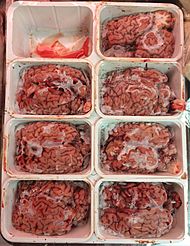Beef brain facts for kids
Beef brains and calf's brains are types of meat eaten in many parts of the world. They are the brains of cows or young cows (calves) prepared as food. People in countries like France, Italy, Spain, Mexico, and Pakistan enjoy them.
Contents
What Are Beef Brains?
Beef brains come from adult cows. Calf's brains, also known as cervelle de veau in French, come from younger cows. These brains are considered a special food in many cultures. They are often prepared in different ways, depending on the country.
How They Taste and Feel
Beef brains have a soft, mushy texture. They do not have a strong flavor on their own. Because of this, they are usually cooked with flavorful sauces. For example, people might use chile sauce or a special sauce called sauce ravigote.
Where Are Beef Brains Eaten?
Beef brains are a popular dish in many countries around the world.
In Europe
- In France, cervelle de veau is a traditional food. It is often served with tongue or mixed with scrambled eggs. Sometimes, it is cooked with a special butter sauce called beurre noir and capers.
- In Italy, a dish called cervella fritte is popular. This dish uses small pieces of beef brain that are fried in batter.
- Spain and Portugal also have dishes that use beef brains.
In Other Countries
- In Mexico, beef brains are called sesos. They are often used as a filling for tacos and quesadillas.
- In Pakistan and Bangladesh, they are known as Maghaz.
- People in El Salvador and Indonesia also include beef brains in their cooking.
- In the United States, beef brains were once popular in places like St. Louis, Missouri and the Ohio River valley.
Safety and Health
For a while, there were concerns about a disease called bovine spongiform encephalopathy (BSE). This disease is sometimes called "mad-cow disease." It affected cows and could, in very rare cases, affect humans who ate certain parts of infected animals.
How Risks Were Reduced
Because of these concerns, new rules were made to make sure beef brains and other parts of cows are safe to eat. These rules helped to reduce any risks of getting the human version of the illness from eating beef. Today, strict safety measures are in place to protect public health.


